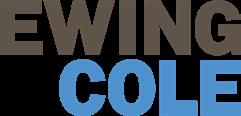




Dear Readers,
Welcome to this special edition of Momentum, where we celebrate the enduring legacy of one of our most cherished projects: Citizens Bank Park, home of the Philadelphia Phillies. As we mark the 20th anniversary of its opening, we look back at the vision and design principles that have made this ballpark not just a venue for baseball but a true reflection of the city’s spirit, culture, and community.
In this issue, you will discover the story of how our design team at EwingCole, in collaboration with the Phillies, created a space that captures the essence of Philadelphia—from its iconic streetscapes and cultural landmarks to its unwavering love for the game. You’ll learn how thoughtful investments and a commitment to innovation ensure its place as a premier sports venue.
We hope these stories inspire you to see how architecture can do more than create buildings; it can shape experiences, foster connections, and, above all, honor the people and places it serves. Enjoy this celebration of a ballpark that, much like the city it calls home, grows more remarkable with each passing year.

Warm regards,

Robert A. McConnell, AIA President


READ. SHARE. ENJOY. momentum
100 N. 6th St • Philadelphia, PA 19106 P: 215.923.2020 • ewingcole.com
EDITOR
Joseph Donahue
WRITER
Zachary DeRitis
DESIGNER
Christopher Mayrides
CONTENTS:
4. 12. 24.
CLASSIC
The Road to Pattison Avenue: Finding a New Home for the Phillies
CONTEMPORARY
The Gang Goes Yard: What Makes Citizens Bank Park’s Design a Home Run
CONTINUING
A Fine Vintage: How the Bank Will Last 100 Years
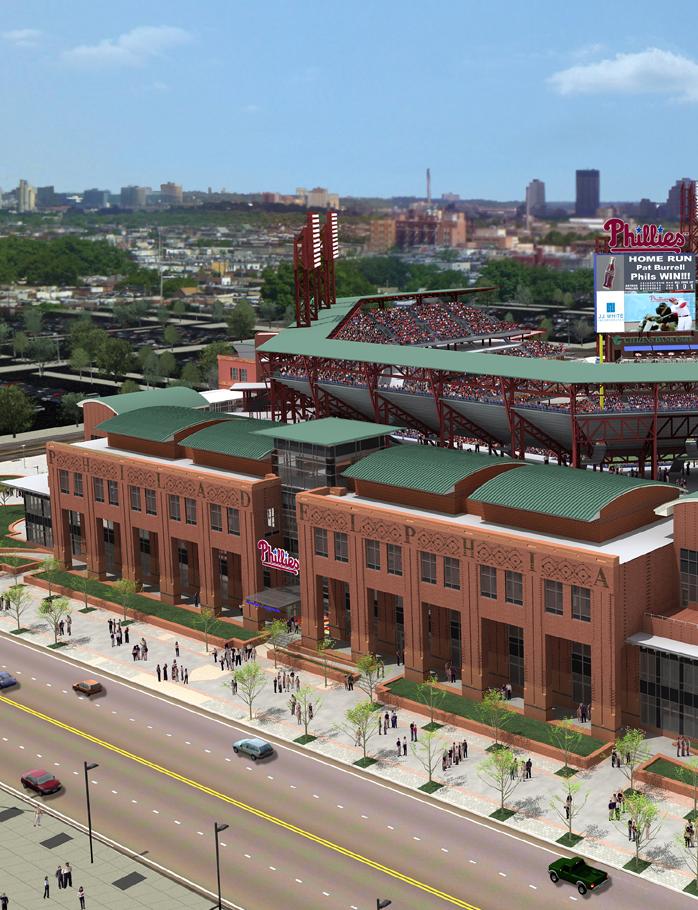

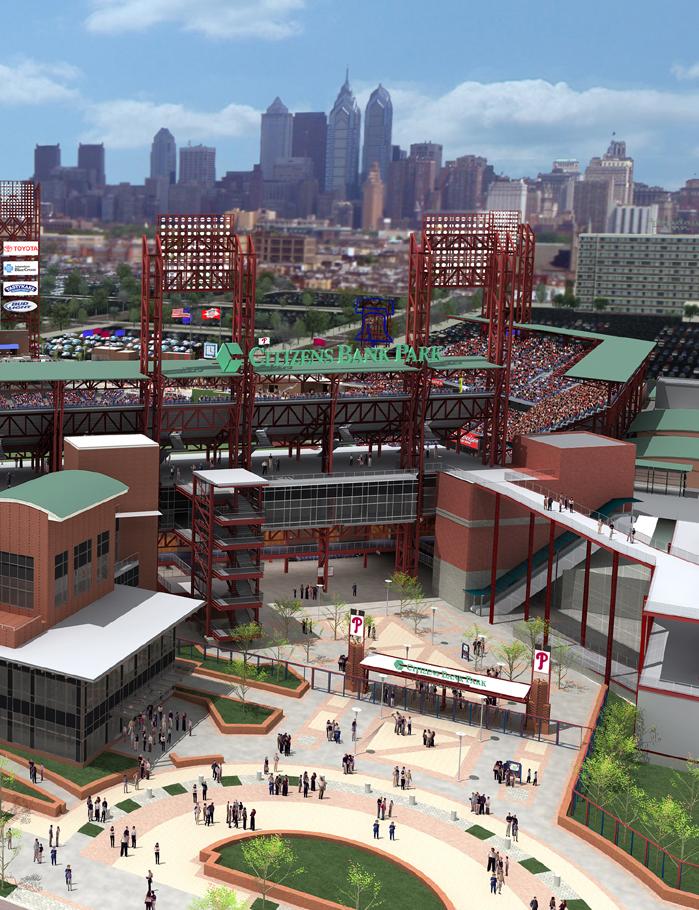
FENWAY PARK, WRIGLEY FIELD, DODGER STADIUM - THESE ARE JUST SOME OF THE NAMES THAT COME TO MIND WHEN REFLECTING ON AMERICA’S LEGENDARY BALLPARKS. THEIR GREATNESS IS MEASURED BY VARIOUS METRICS: ACCESSIBILITY, FAN EXPERIENCE, AND LEGACY. IN 1991, THE PHILADELPHIA PHILLIES DECIDED THEY WANTED TO ADD THEIR OWN STADIUM TO THE PANTHEON OF BASEBALL GREATS.
From 1971 through 2003, the Phillies called South Philadelphia’s Veterans Stadium home and they shared the facility with the National Football League’s Philadelphia Eagles. The Vet, as it was locally known, had fallen into obsolescence and lacked the elements that cater to the time’s baseball fan base or that would lend itself to being one of baseball’s great venues. The appealing concept of a multi-purpose facility was in fact its failing; the Vet was a compromised facility that was not an ideal venue for any sport.
EwingCole has a longstanding relationship with the Phillies, dating back nearly 60 years, assisting the Phillies with a baseball-only facility in the mid 60’s and designing multiple upgrades and modifications to The Vet and working extensively on the Clearwater, Florida, Spring Training facilities. It came as no surprise when the firm was tapped to help find a site and design a new home for the Phils in March 1993.
“EwingCole had done a lot of work for us for a long time. They are a sound firm and understood our organization’s design goals as well,” said the late David Montgomery, the former minority owner, and president of the Phillies.
By the fall of 1993, project architects Bob McConnell and Don Jones were working on plans for proposed sites throughout Philadelphia, as well as a plan to convert Veterans Stadium into a baseball-only, purpose-built park. Over the next 7
years several options for a new park, for multiple sites in Center City or a modified Veterans Stadium were discussed among the organizations, the local government, and the community.
In 2000, the Phillies and the city of Philadelphia decided on the South
others. Their goal was to identify the best design elements to incorporate and potential pitfalls to avoid in creating a new ballpark. Then Philies President David Montgomery played an active and hands-on role alongside EwingCole. During these visits, Montgomery was meticulous,
“ EWINGCOLE HAD DONE A LOT OF WORK FOR US FOR A LONG TIME. THEY ARE A SOUND FIRM AND UNDERSTOOD OUR ORGANIZATION’S DESIGN GOALS AS WELL. ”
- David Montgomery, Former Chairman, Minority Owner, and President, Philadelphia Phillies
Philly sports complex as the site for the new ballpark, adjacent to what would become the former Veterans Stadium.
“After almost ten years of site selection, traffic and utility studies, and community and stakeholder meetings, we were relieved to finally be working on the actual project,” said Jones.
That decade of planning and identifying a new site for the park gave the team the time to fully realize what the Phillies wanted in a new ballpark.
The EwingCole team embarked on a comprehensive tour of recently constructed ballparks, drawing inspiration from Baltimore, Detroit, San Francisco, and Colorado, among
insisting on experiencing the best and worst seating views in each park. He assembled a dedicated team to scrutinize every detail of the new ballpark's design from initial concepts to the completion of construction.
“All that time provided us with a learning curve so we could ask the Phillies, ‘What would you have done differently? What would you have done if you had a second chance?’ and a lot of ideas for the new ballpark came out of those conversations after visiting other cities,” said McConnell.
“Our colleagues across the industry remarked that they had never seen a team president as involved as Dave was,” said Jones. “His hands-on approach ensured a comprehensive



understanding and execution of the ballpark design.”
Montgomery’s vision was the north star for the design team. His aspiration for the Phillies’ new home was to incorporate the best aspects of the great pre-war ballparks while providing modern amenities and using the latest technological advancements in sports entertainment. Always cognizant of the need to build a facility that appealed to a wide range of fans, from the fanatical to the casual, Montgomery also wanted to understand what features of the recent stadiums appealed to different people. With that vision firmly established and the Vet set for demolition, it was time to start laying the groundwork for the new stadium.
The new site, however, presented significant challenges for the design team. After considering several site options, a 21-acre block was chosen from a 110-acre area just north of Pattison Avenue and bounded by Darien Street, 11th Street (renamed Citizens Bank Park Way), and Hartranft Street (renamed Phillies Drive). The field was rotated to align the home
plate-centerfield axis to provide the largest possible number of fans a great view of downtown Philadelphia as they enjoyed the game. Multistory buildings surrounded the uniquely angular seating bowl and faced the new street on the west, Pattison Avenue on the south, and Darien Street on the east, solidifying the ballpark’s place in the city’s grid of streets.
The Phillies wanted a seamless entry experience from the street to the entry plazas to the concourses, as well as an open view of the field from the main concourse, requiring the field elevation to be 23 feet below street level and 10 feet below the water table. This necessitated a substantial excavation project, which could not commence until various utilities on nearby 10th Street were relocated. The relocation involved careful planning and coordination between the design team, the city of Philadelphia, and utility companies, as the street carried critical services, including electrical, sewer, water, gas lines, and telecommunications. All the pieces of the site’s puzzle had to fit perfectly.
“Veterans Stadium’s field was below grade as designed by a team including EwingCole’s predecessor firms, and we had helped with the dewatering equipment’s maintenance, so the technical solution was well understood,” said Jones.
Being so low below the water table - the boundary between the saturated and unsaturated zones of groundwater - geotechnical engineers were brought in to maintain a dry site during and after construction.
With utility relocation and excavation completed, the team devised an environmentally sensitive and cost-effective solution for storing the excavated soil. The excavated material was transported and monitored by the Pennsylvania Department of Environmental Protection and was eventually used to fill the hole created by the demolition of Veterans Stadium.
With the groundwork underway, the design team began charting the path forward for what would become Citizens Bank Park, one of the best ballparks in Major League Baseball. EC
“
ALL THAT TIME PROVIDED US WITH A LEARNING CURVE SO WE COULD ASK THE PHILLIES, ‘WHAT WOULD YOU HAVE DONE DIFFERENTLY? WHAT WOULD YOU HAVE DONE IF YOU HAD A SECOND CHANCE?’ AND A LOT OF IDEAS FOR THE NEW BALLPARK CAME OUT OF THOSE CONVERSATIONS AFTER VISITING OTHER CITIES ”
- Bob McConnell, President,
EwingCole
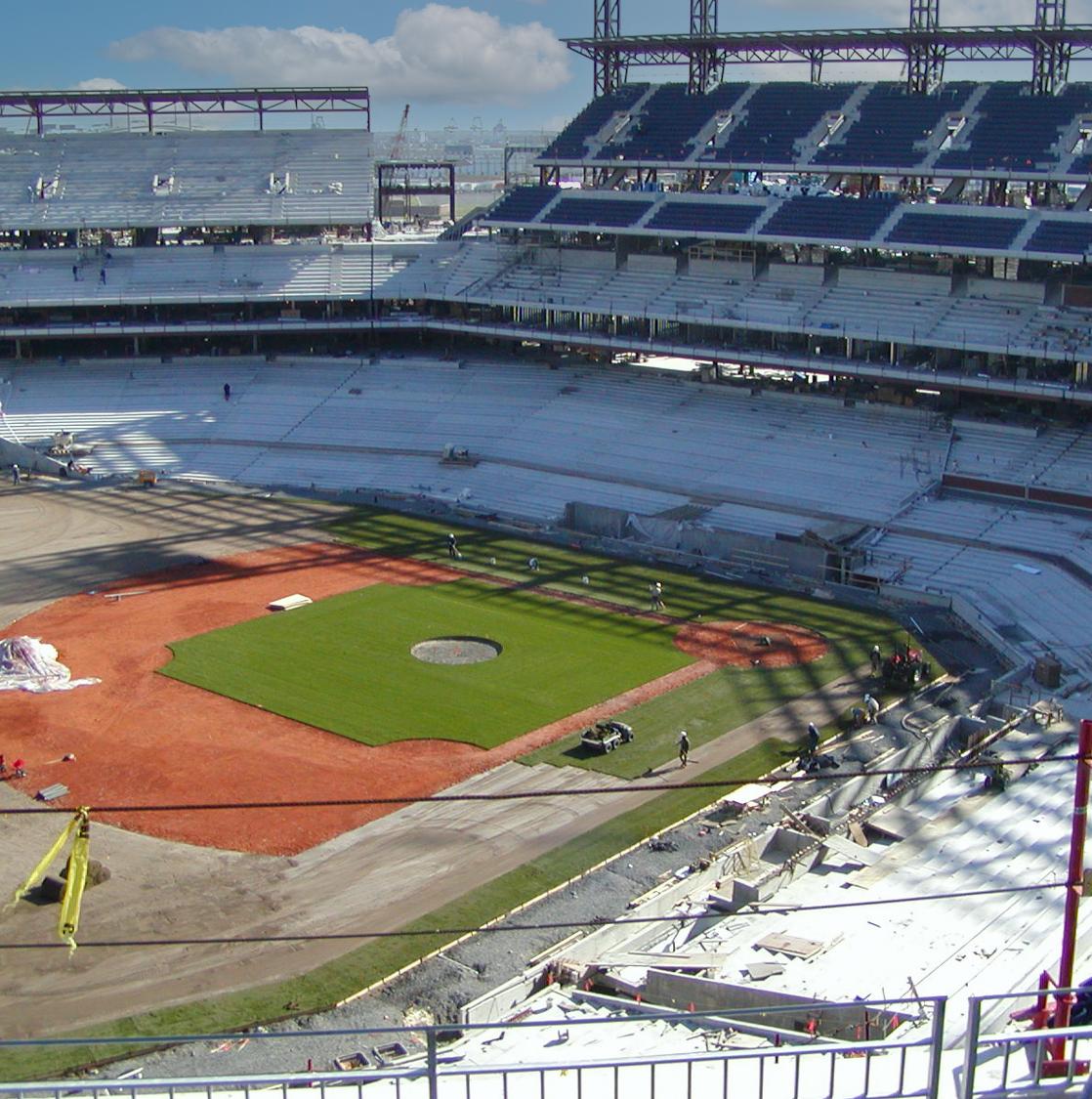


“ OUR COLLEAGUES ACROSS THE INDUSTRY REMARKED THAT THEY HAD NEVER SEEN A TEAM PRESIDENT AS INVOLVED AS DAVE WAS, HIS HANDS-ON APPROACH ENSURED A COMPREHENSIVE UNDERSTANDING AND EXECUTION OF THE BALLPARK DESIGN. ”
- Don Jones, Project Architect, EwingCole
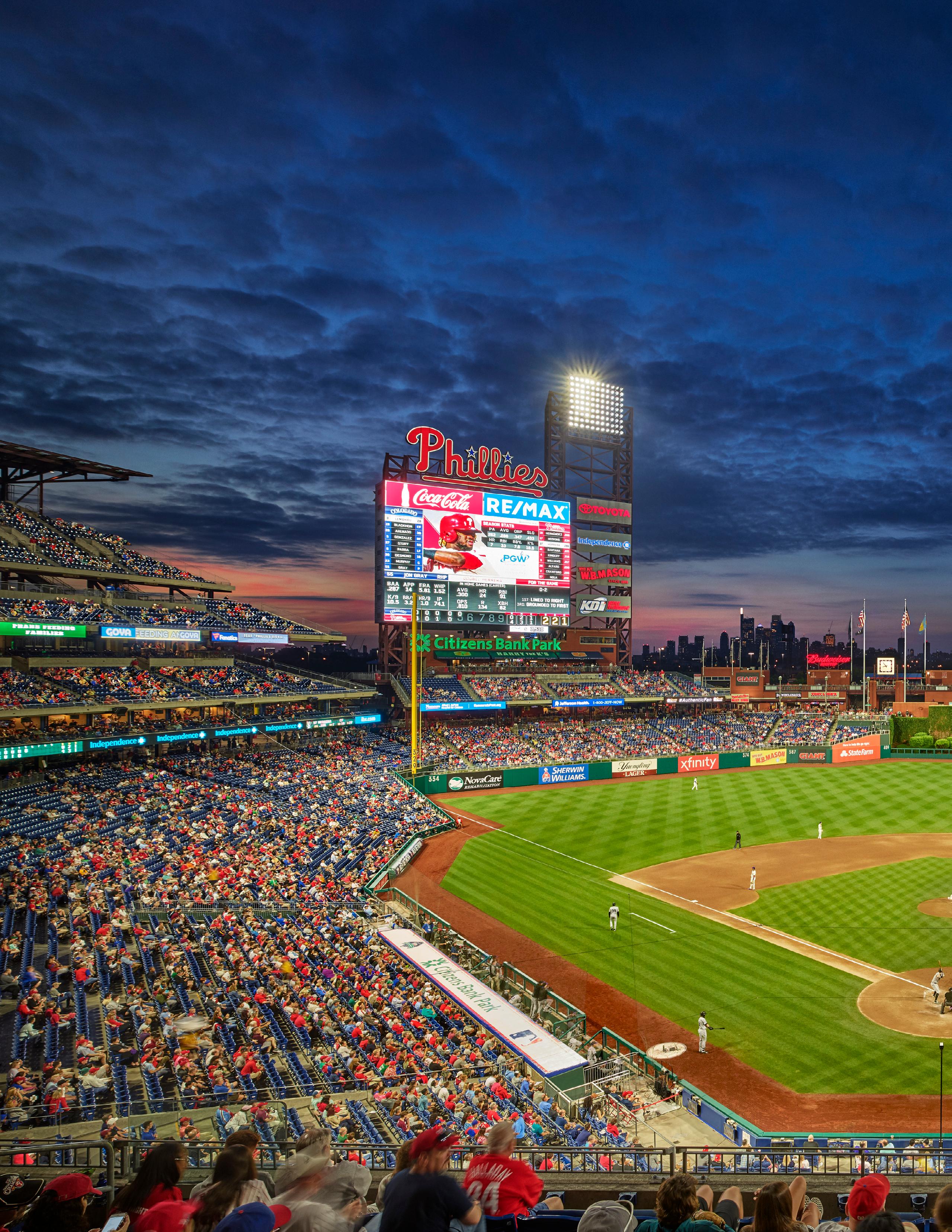
Makes Citizens Bank Park’s Design a Home Run

PHILADELPHIA FANS ARE AS INTEGRAL TO CITIZENS BANK PARK’S STRUCTURE AS THE STEEL, CONCRETE, AND BRICKS. THEY’RE THE BACKDROP TO HISTORIC PHILLIES MOMENTS, LIKE BRAD LIDGE’S CLOSING STRIKEOUT PITCH TO CLINCH GAME 5 OF THE 2008 WORLD SERIES, RHYS HOSKINS’ BAT-SLAMMING THREE-RUN HOMER IN GAME 3 OF THE 2022 NLDS, OR BRYCE HARPER’S “BEDLAM AT THE BANK” GAME-WINNING HOME RUN IN THE EIGHTH INNING IN GAME 5 OF THE SAME SERIES - SENDING THE PHILLIES TO THE WORLD SERIES FOR THE FIRST TIME SINCE 2009.


The roar from the stands is the soundtrack to every one of the unforgettable Phillies memories over the last two decades.
Fans obviously turn up to see a good club win, but the ballpark itself makes the experience worth seeing in person, win or lose. The design team sought to create a park that makes it all worthwhile.
The Vet closed after the 2003 Phillies season to make way for the two new venues for the Eagles and Phillies. As beloved as it was, the Vet was never ideal for football or baseball, and by the time it closed, fan expectations for amenities had significantly evolved.
The design team behind Citizens Bank Park and the Phillies recognized this shift and set clear goals to enhance the fan experience. Their innovative
strategies translated into technical and planning solutions that have become hallmarks of the park’s success.
One of the primary design goals was to create a ballpark with unobstructed, spectacular views from every vantage point.
“Whether you’re in a suite, the last row in the upper seating section, or on the concourse our goal was to make sure you could see the game from no matter where you are in the stadium,” said Bob McConnell, now president at EwingCole.
To maintain unobstructed sightlines, the first line of supporting columns is located behind the furthest seat in the lower seating bowl. This creates cantilevered conditions at the Suite, Club, and Upper Concourse Levels.
As fans enter the main street-level entry plazas, they have a clear visual connection through the concourse
to the field. That’s because the field is recessed 23 feet below the street, creating a clear path to the 100-level seats. All fixed concessions on each concourse and structural elements are set away from the field, allowing fans to view the game while walking the concourse.
“The four main tiers wrap around the field in the shape of an octagon, broken at various points to permit views in and out. Those visual connections are a major design theme and should give the ballpark the sociability of an ongoing block party,” said Inga Saffron, architectural critic for The Philadelphia Inquirer. “Whether you’re prowling the concourse in search of a snack, standing with a friend and a beer at the drink rails, or perusing the Ashburn Alley food court behind center field, you are always able to maintain a visual connection with the game.”
A PARK THAT KEEPS EVOLVING
So, what might you be doing at

“ THE ARCHITECTS MANAGED TO PUT HALF OF THE PARK'S 43,000 SEATS AT FIELD LEVEL - A TRULY ASTONISHING ACHIEVEMENT ”
-
Inga Saffron, Philadelphia Inquirer Architectural Critic


Citizens Bank Park when not in your seat waiting for that foul ball to fly your way? The answer is plenty! In 2018 and 2019, EwingCole, DAIQ, Janet Marie Smith, Alan Metcalfe, and Younts Design introduced a new wave of fan amenities designed to delight visitors of all ages. The litany of projects was awarded “Best Continual Ballpark Improvement” by Baseball Digest.
“There wasn’t really a need to do anything drastic or dramatic, so the series of improvements that were made were really focused and really targeted to a couple of
areas that could’ve benefited from being improved and just made a little more modern with things like Instagrammable moments, which really didn’t exist in 2004,” EwingCole Principal Kevin Murphy, RA, told Ballpark Digest.
Thanks to those enhancements, Citizens Bank Park continues to be a hub of fan engagement. The Yard, for example, a mini ballpark tailored to kids, gives young fans a place to play games and enjoy ballpark snacks, like the fan-favorite soft-serve ice cream in a miniature batting helmet.
The “Wall of Fame” area pays tribute to Phillies greats, offering a deeper connection to the team’s storied history. A display of retired numbers and pennants complements the Wall, visually celebrating the franchise's legends and milestones.
“We added a large number of displays to help keep fans engaged while traversing the ballpark’s new features. There were a couple of areas that we thought could be better utilized,” said Murphy. “There was nearly 20 years of good team history that wasn’t there when we built the park, so we wanted to find a place to celebrate that.”
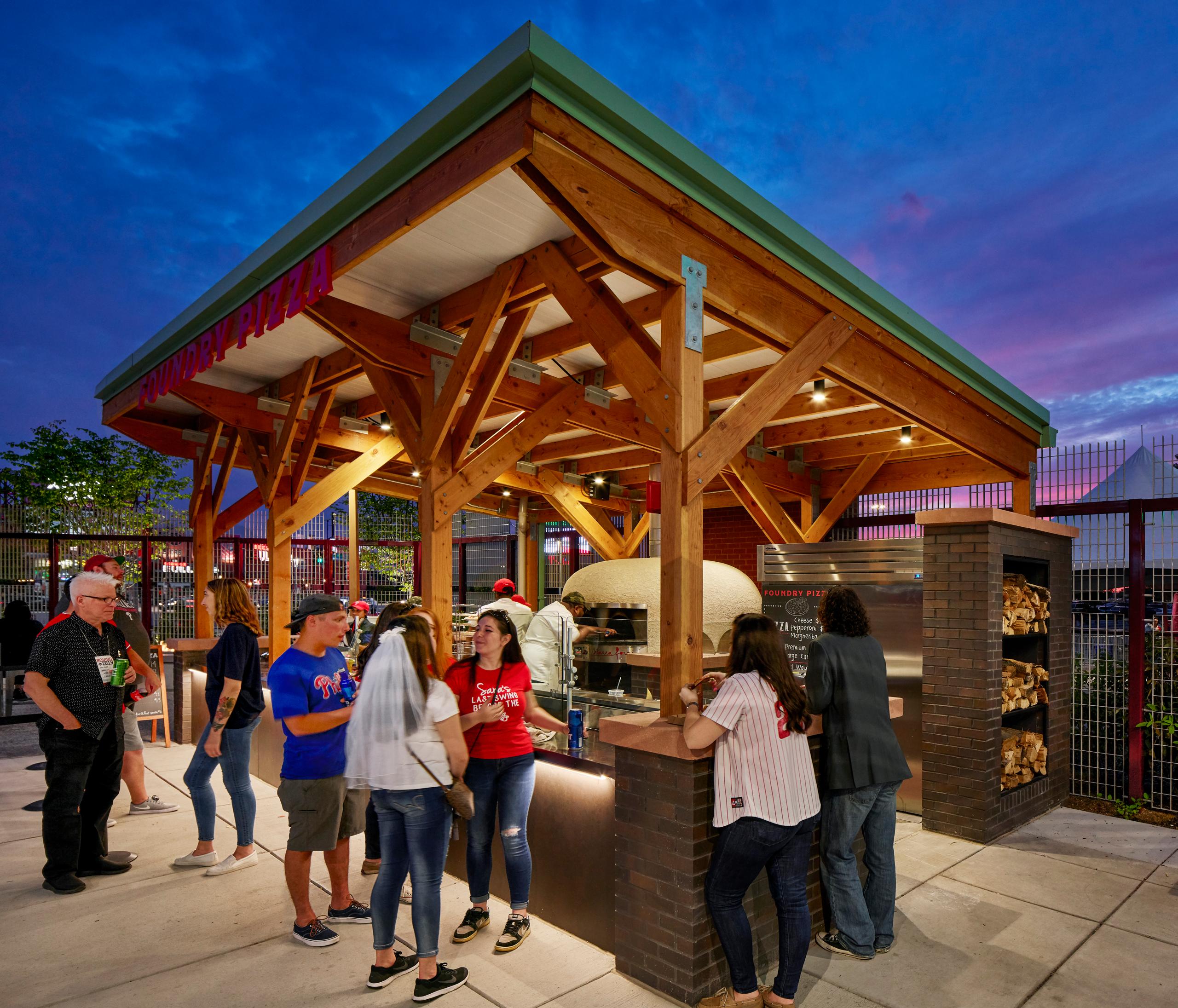
Food has played a critical, supporting role in the park’s upgrades, from seating and standing-room-only options to transformative concessions, bars, and food and drink carts. Fans never have to go far to grab a bite or a drink, and keeping those menu options local was critical.
“People's expectations of the ballpark food and beverage experience have changed,” he said. “When Citizens Bank Park was built, most teams were still focused on beer and hot dog sales. After
a while, the idea of bringing in local eateries just exploded. It became not just a new, unique idea but an expectation.”
Ashburn Alley in center field is flush with food and drink options, and Bull’s BBQ, named for former Phillies outfielder Greg “The Bull” Luzinski and a Citizens Bank Park favorite, was moved to the left field corner, giving it ample space for dining. Back closer to homeplate, Pass and Stow, provides fans with a backyard BBQ vibe. It features an outdoor bar, firepits, and a pizza oven station, adding to the park’s communal atmosphere.
“The original concept for the ballpark was to get everyone in off the street and to a view of the field as fast as possible. The plazas were more passthroughs. In 2019 we re-thought the idea and connected the third base plaza with Pass and Stow to create more of a destination, pre-, during and post-game,” said Murphy.
These are just some of the highlights. The park has ample concessions, bars, drink rails, benches, tables, and bar stools to support a hungry (and thirsty) crowd without them missing a pitch.


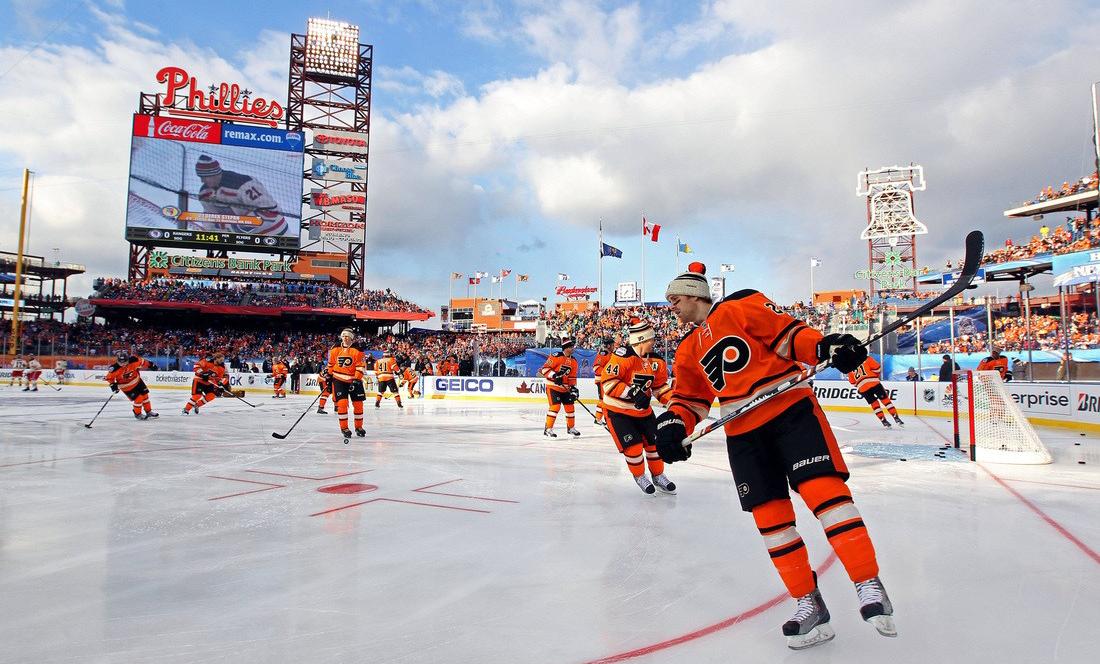
The park’s commitment to staying at the forefront of stadium technology is evident in its recent upgrades, which enhance the fan experience and operational efficiency. The introduction of LED field lighting provides superior visibility and reduces energy consumption by 50 percent, aligning with modern sustainability goals. Additionally, infrastructure upgrades, including concrete repairs, repaving, and HVAC improvements, ensure the park remains a comfortable and wellmaintained environment.
A new scoreboard, among the largest in MLB, ensures that fans don't miss a beat. Installed in 2023, the new scoreboard, or ‘PhanaVision’ as the organization has dubbed it, is 152
feet wide and 86 feet tall – making it 77 percent larger than the previous display. For size reference, the new scoreboard can fit 516 life-size Phillie Phanatics. It is complemented by enhancements to other displays, AV systems, and controls.
Citizens Bank Park isn’t
just a home for baseball. It hosts a myriad of events year-round, from concerts to other sporting events and college graduations, making full use of its expansive space. Since Jimmy Buffett & The Coral Reefer Band first performed there on August 25, 2005, the ballpark has welcomed over 41 concerts, with each event requiring meticulous egress and security planning by EwingCole’s architects and life safety team.
As fans pour into Citizens Bank Park, it’s clear that the design - from its ease of access to its abundant entertainment options - continues to be a massive draw. The ballpark’s legacy is built on its ability to provide a phenomenal inperson experience, game after game, year after year. More than 3 million fans attended in nine of the 20 seasons, including a 257-game regular-season sellout streak from July 2009 to August 2012.
In the end, what makes Citizens Bank Park great is a harmonious blend of passionate fans, innovative design, and the unforgettable experiences that come with every game, every concert, and every event held within its grounds. It’s a place where history is made, one pitch, one swing, and one roar at a time. EC
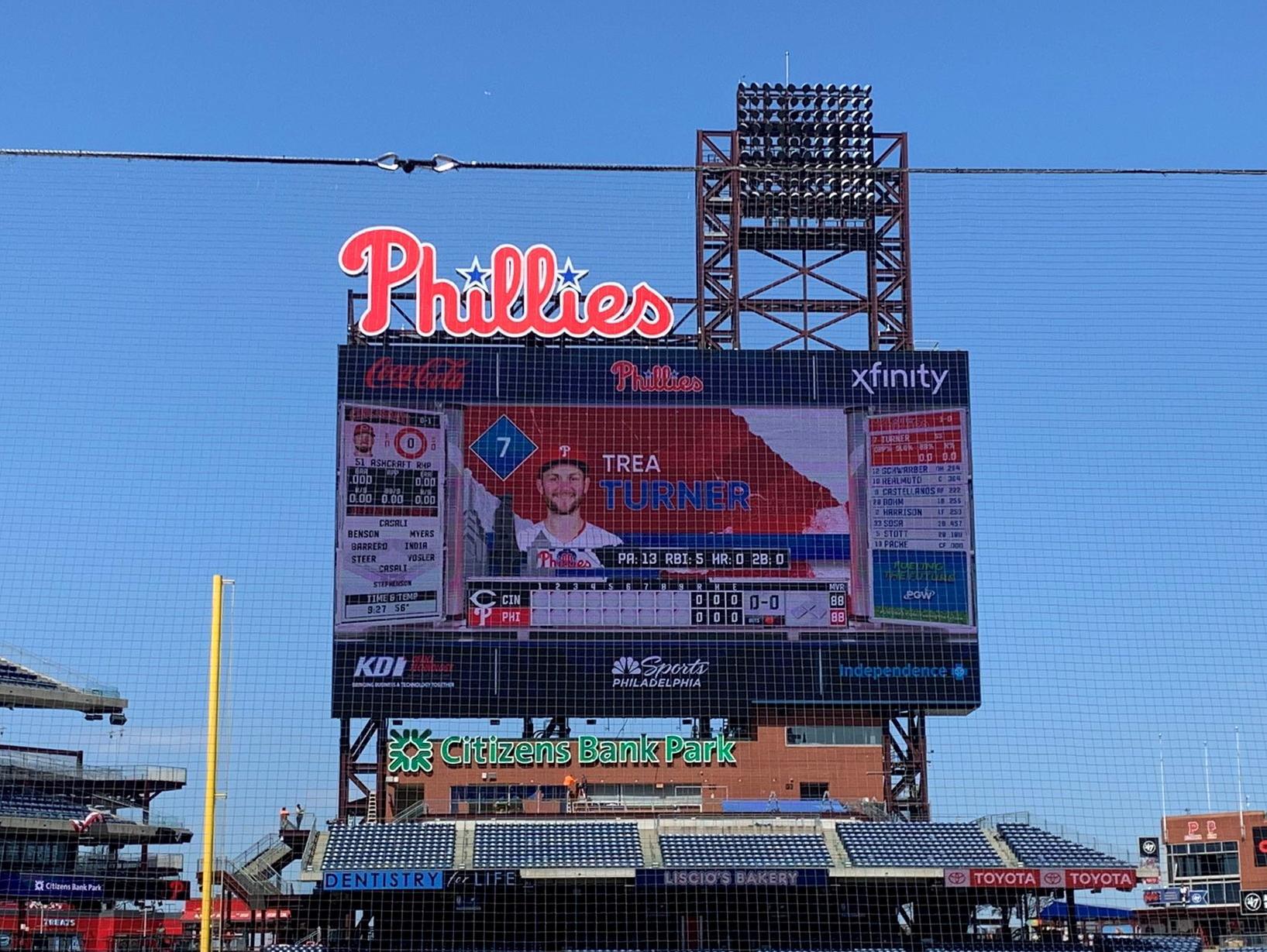


“ PEOPLE'S EXPECTATIONS OF THE BALLPARK FOOD AND BEVERAGE EXPERIENCE HAVE CHANGED, WHEN CITIZENS BANK PARK WAS BUILT, MOST TEAMS WERE STILL FOCUSED ON BEER AND HOT DOG SALES. AFTER A WHILE, THE IDEA OF BRINGING IN LOCAL EATERIES JUST EXPLODED. IT BECAME NOT JUST A NEW, UNIQUE IDEA BUT AN EXPECTATION. ”

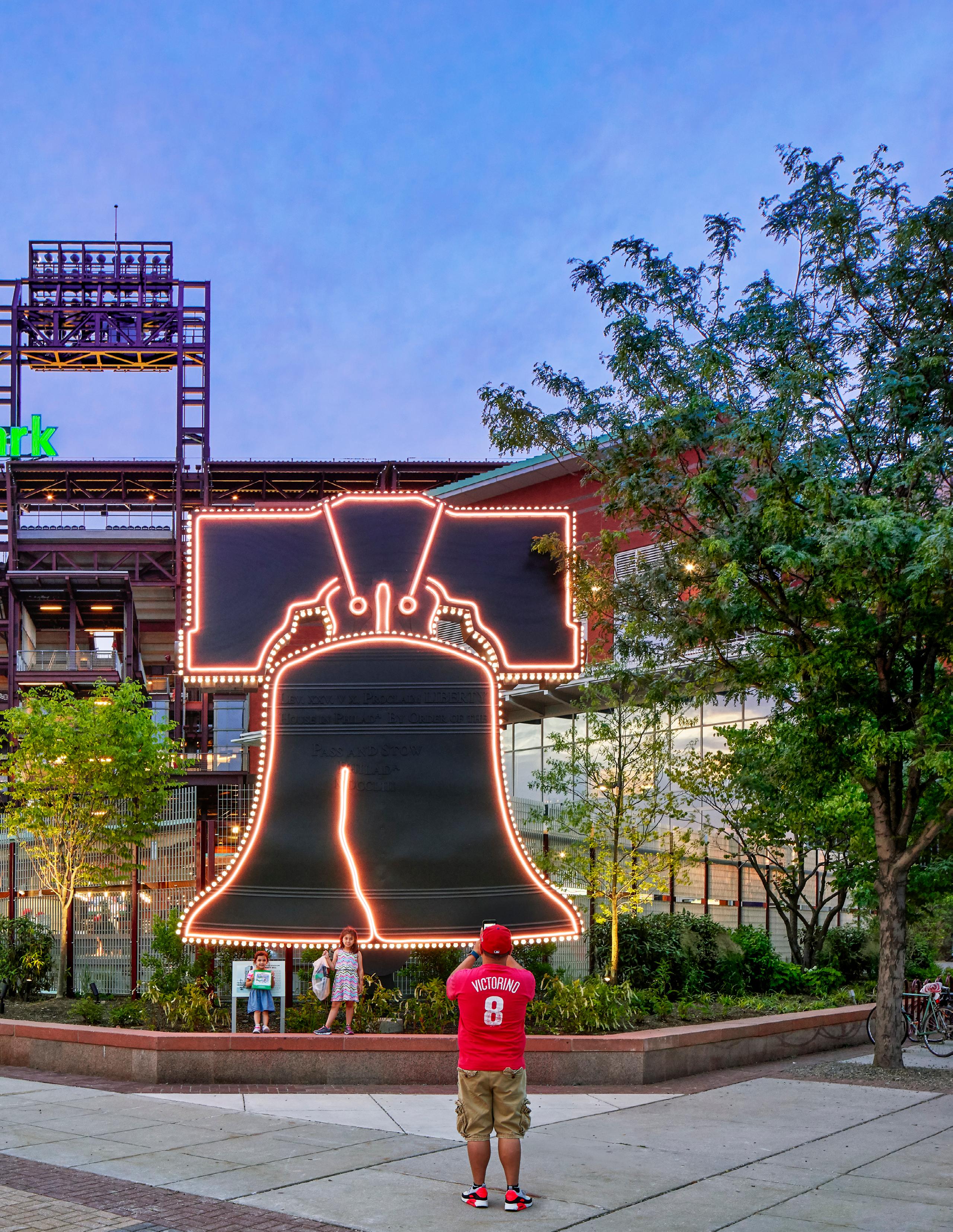
“BASEBALL
STADIUMS AGE WELL, LIKE A GREAT WINE,” PHILLIES MANAGING PARTNER AND CEO JOHN MIDDLETON
REMARKED EARLIER THIS YEAR TO THE PHILADELPHIA INQUIRER.
Wine’s aromas, balance, and complexities are reflective of the soil in which their grapes take root - love letters to home. If Citizens Bank Park were a vintage, it would pair perfectly with soft pretzels and cheesesteaks, offering hints of a cold beer on a warm summer evening.
Citizens Bank Park has much in common with fine wine. The stadium feels like a love letter to the City of Brotherly Love and Sisterly Affection. In a city steeped in history and tradition, the Bank pays homage to Philadelphia’s unique blend of grit and charm, capturing the essence of its people, its places, and, of course, its love of baseball.
The aging process, like wine, isn’t self-sustaining. The secret to any ballpark’s longevity is continuous investment, allowing it to evolve to meet the changing expectations of both fans and players, notes Craig Schmitt, RA, EwingCole principal, and ballpark designer.
“The Phillies have consistently invested in the ballpark, which is why it has

retained its draw for the people of this region,” Schmitt said. “It’s crucial for organizations to keep reinvesting in their facilities.”
The Phillies routinely update their technology, amenities, and features, ensuring the park stays modern and connected to its fanbase. Bob McConnell, EwingCole president, echoed Schmitt’s sentiment, saying, “I believe the Phillies should be applauded for their ongoing improvements. Over the past two decades, they’ve consistently asked, ‘What can we do to make this better?’ rather than allowing the ballpark to slip into obsolescence.”
The Phillies recognized the need to create an environment that enhances the experience for casual fans and baseball purists alike. In preparing for the project, the Phillies and the design team assembled examples of Philadelphia’s cultural artifacts, traditions, buildings, architecture, and engineering works as touchstones for the design. The architects looked to the Benjamin Franklin Bridge, the Liberty
Bell, the Mummers, the 9th Street Italian Market - and many other places, buildings, and symbols that define Philadelphia and Philadelphians - to create the visual and cultural context for a stadium visited by a fan base passionate about its hometown.
The resulting design becomes an integral thread in the tapestry of the city. The brick façade of the exterior buildings is a nod to the city’s colonial and working-class neighborhoods, comprised of hundreds of city blocks clad in red and black brick and granite.
The entrances to the park have a distinct character and focus, echoing the city of Philadelphia’s urban plan with its unique squares - Franklin, Rittenhouse, Logan, and Washington – analogous to William Penn’s original urban plan.
Citizens Bank Park doesn’t just celebrate the city’s physical attributes but also its character. Philly, as first baseman Bryce Harper once put it, has a “blue-collar mentality.” He’s not the only one in the organization who


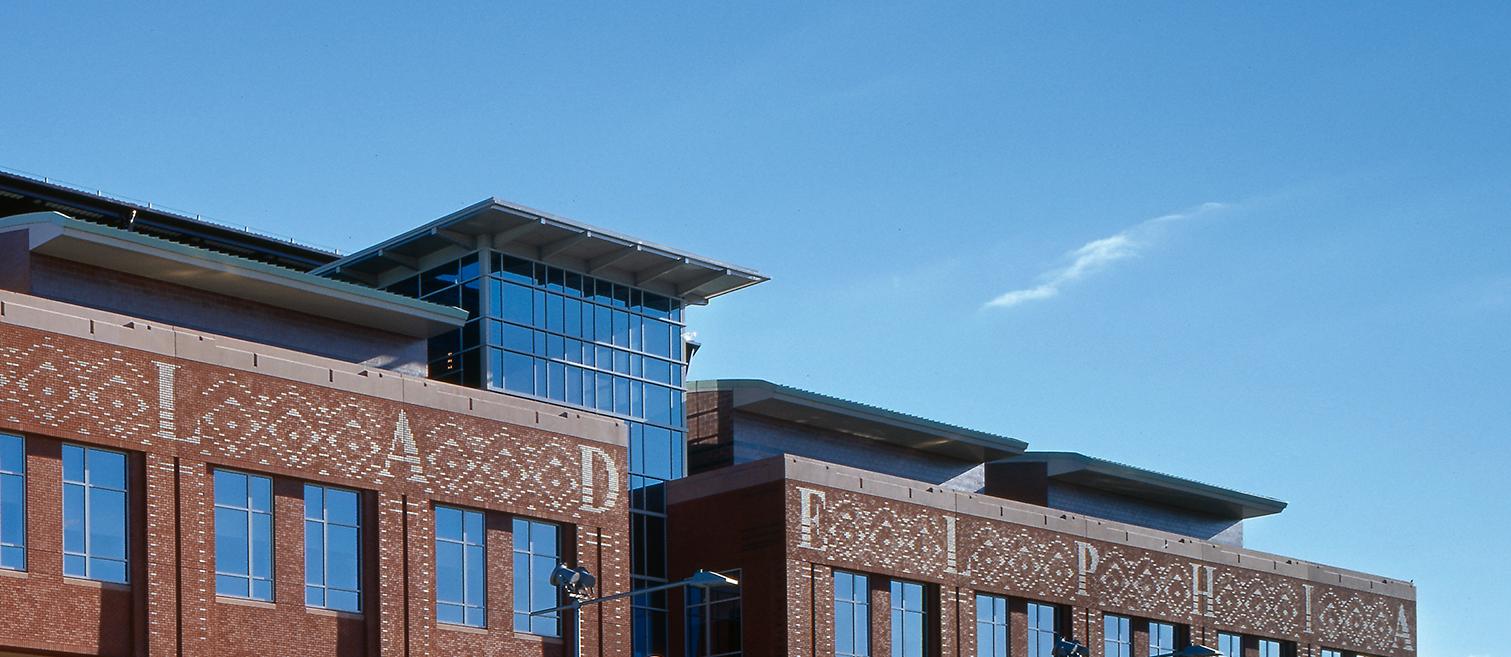

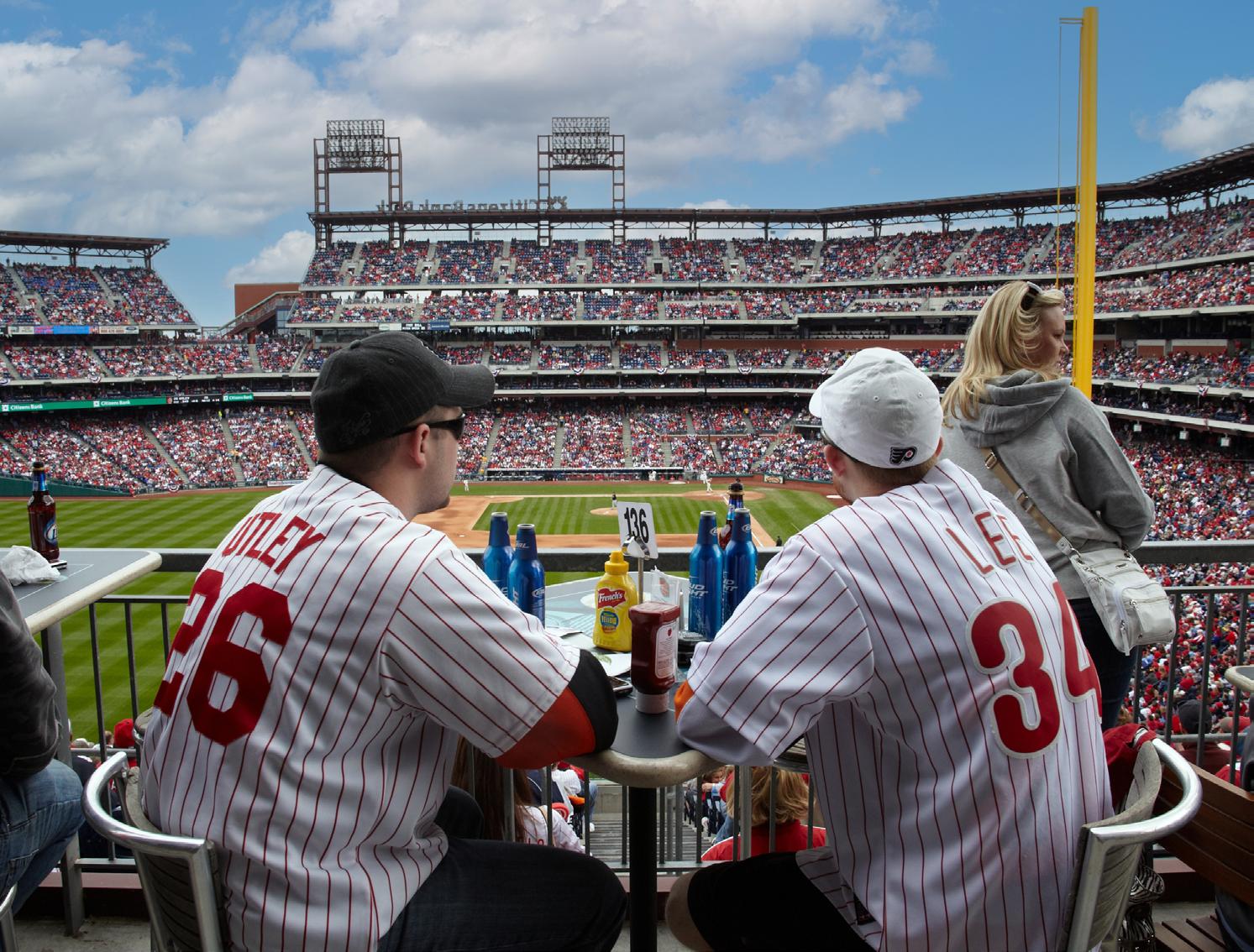
values that lifestyle. The Phillies have made it a priority to keep all their fans comfortable and happy during their visits to the park.
“Most teams invest heavily in their premium customers by adding exclusive clubs and enhancing premium amenities every year,” said McConnell. “The Phillies haven’t taken that approach; instead, they have prioritized new amenities and attractions for the everyday fan. Even after 20 years, the stadium remains a ballpark for everyone.”
Their investment strategy in the park is yielding results. This approach has allowed the Phillies to attract and retain star players like Harper, Zack Wheeler, and Trea Turner - all of whom extended their contracts because they wanted to play in Philadelphia, in front of Philly fans, and at Citizens Bank Park.
Founded in 1883, the Phillies are the oldest, continuous, one-city franchise in all of professional sports. The team has called several stadiums home over the years, beginning with Recreation Park (1883 to 1886) and then Baker Bowl (1887 to 1938). They then moved to Shibe Park, renamed Connie Mack Stadium in 1953 to honor the legendary
Philadelphia Athletics manager. They played there from 1938 until 1970 before moving to The Vet in ’71 and Citizens Bank Park in ’04. The design team aimed to honor that lineage, which many fans still hold dear.
“The designers of the Bank went to great efforts to pay homage to Shibe Park -- the Phillies’ old ballpark at Lehigh Avenue and 20th Street,” said Harris Steinberg of the Philadelphia City Paper. “Like Fenway Park in Boston and Wrigley Field in Chicago, Shibe - Connie Mack - was smack in the middle of a working-class neighborhood and benefited from the density and buzz of its setting.”
The Liberty Bell, a powerful symbol of Philadelphia, has featured prominently in the team's logos and stadiums throughout its history, reflecting its significance. A steel and aluminum bell replica that once sat atop Veterans Stadium now greets fans as they enter the third base gate. It had been lost for years following the Vet’s demolition.
The bell was restored and installed at Citizens Bank Park on the 15th anniversary of Veterans Stadium’s demolition in 2004. It now stands outside the Pass and Stow section of the ballpark—a name inspired by the


two Philadelphia craftsmen who recast the original Liberty Bell in 1753.
“There was a growing movement to recognize the past and more recent history, and the two concepts converged,” said Kevin Murphy, RA, EwingCole principal.
The Toyota Phillies Wall of Fame, located at the Left Field entry plaza, features two large replicas of the team’s two World Series trophies and statues of retired numbers. This feature not only creates a memorable welcome for fans entering through the gate but also provides several prime spots for selfies at Citizens Bank Park.
“They created a ballpark that contains so many special touches that it will take you several visits to discover and adequately appreciate them all,” said Joe Mock, writer at Baseballparks.com.
By maintaining a commitment to accessibility, inclusivity, and evolution, the Phillies have cultivated a unique sense of community within the ballpark— one that appeals to and embraces everyone. It keeps fans and players coming back. Citizens Bank Park’s design, coupled with the Phillies’ dedication to the fans, its facilities, and the community, will age like – well – a great wine. EC

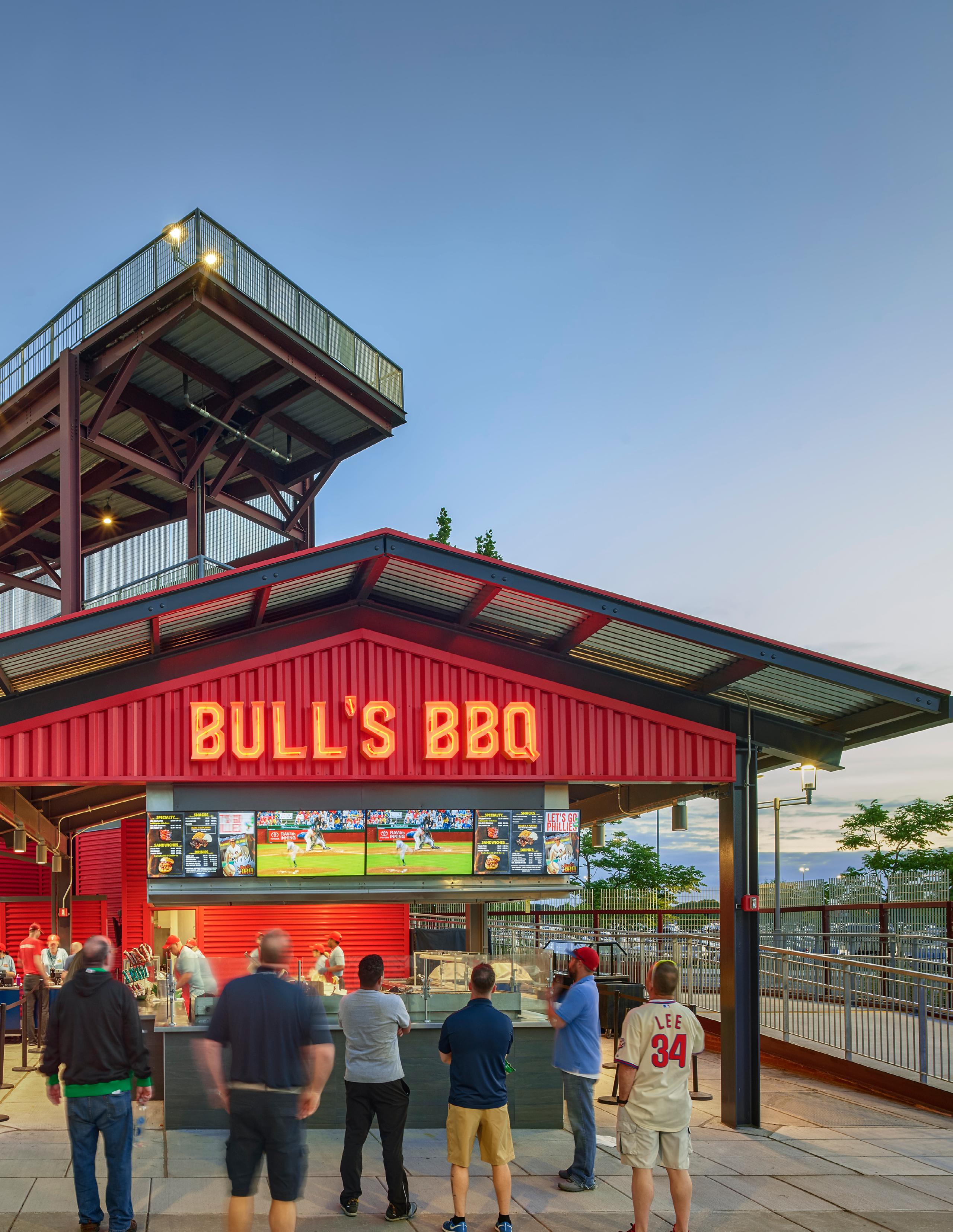
“ A GIANT JEWEL ON THE SOUTH PHILADELPHIA LANDSCAPE. ”

Dear Citizens Bank Park,
As we celebrate your 20th anniversary, we reflect on the journey we've taken together and the incredible experiences you have given to the city of Philadelphia and its people. More than two decades ago, we set out to design a ballpark that would do more than host a baseball team; we sought to create a place where memories are made, where the heart of the city could gather, and where every fan and player could feel at home. To see you stand today as a vibrant, living part of this city fills us with immense pride and gratitude.
It has been an honor to watch you grow and evolve, to see you embraced by fans, their families, and friends who fill your seats, cheer from your rafters, and experience the joy of baseball against the backdrop of this remarkable city. For us at EwingCole, being a part of your story has meant everything. We have grown alongside you, continually inspired by the spirit and energy that fills your walls. Together, we’ve navigated challenges, celebrated triumphs, and shaped an environment that reflects the character of Philadelphia—gritty, resilient, and filled with heart.
Thank you for the past 20 years of partnership and for every moment of laughter, celebration, and even the occasional heartbreak. We look forward to many more years of shared memories and endless possibilities.
Here’s to the next chapter in our shared story.
With appreciation and affection, Your friends at EwingCole
P.S. Go Phillies!
The original design team for Citizens Bank Park: Craig Schmitt, Don Jones, Kevin Murphy, and Bob McConnell featured in a painting by Max Mason that hangs in CBP.
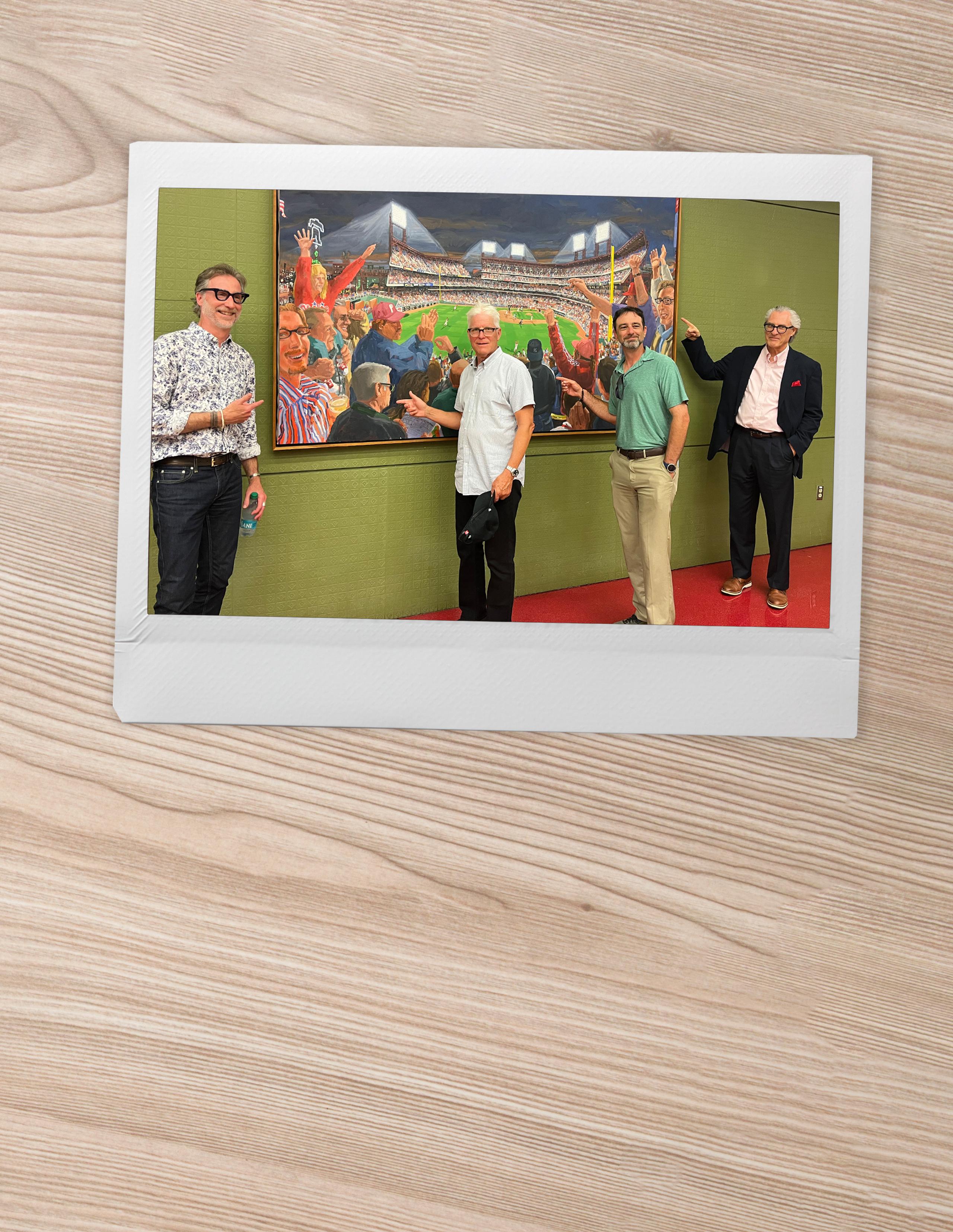
“ THERE’S NO REASON THIS CAN’T BE HERE 100 YEARS. ”
- John Middleton, Phillies Managing Partner and CEO on Opening Day 2024


